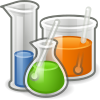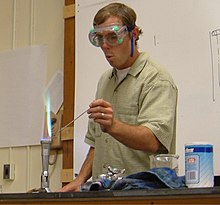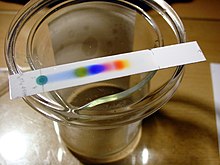
A | B | C | D | E | F | G | H | CH | I | J | K | L | M | N | O | P | Q | R | S | T | U | V | W | X | Y | Z | 0 | 1 | 2 | 3 | 4 | 5 | 6 | 7 | 8 | 9

| Part of a series on |
| Chemistry |
|---|
 |
Analytical chemistry studies and uses instruments and methods to separate, identify, and quantify matter.[1] In practice, separation, identification or quantification may constitute the entire analysis or be combined with another method. Separation isolates analytes. Qualitative analysis identifies analytes, while quantitative analysis determines the numerical amount or concentration.
Analytical chemistry consists of classical, wet chemical methods and modern, instrumental methods.[2] Classical qualitative methods use separations such as precipitation, extraction, and distillation. Identification may be based on differences in color, odor, melting point, boiling point, solubility, radioactivity or reactivity. Classical quantitative analysis uses mass or volume changes to quantify amount. Instrumental methods may be used to separate samples using chromatography, electrophoresis or field flow fractionation. Then qualitative and quantitative analysis can be performed, often with the same instrument and may use light interaction, heat interaction, electric fields or magnetic fields. Often the same instrument can separate, identify and quantify an analyte.
Analytical chemistry is also focused on improvements in experimental design, chemometrics, and the creation of new measurement tools. Analytical chemistry has broad applications to medicine, science, and engineering.
History

Analytical chemistry has been important since the early days of chemistry, providing methods for determining which elements and chemicals are present in the object in question. During this period, significant contributions to analytical chemistry included the development of systematic elemental analysis by Justus von Liebig and systematized organic analysis based on the specific reactions of functional groups.
The first instrumental analysis was flame emissive spectrometry developed by Robert Bunsen and Gustav Kirchhoff who discovered rubidium (Rb) and caesium (Cs) in 1860.[3]
Most of the major developments in analytical chemistry took place after 1900. During this period, instrumental analysis became progressively dominant in the field. In particular, many of the basic spectroscopic and spectrometric techniques were discovered in the early 20th century and refined in the late 20th century.[4]
The separation sciences follow a similar time line of development and also became increasingly transformed into high performance instruments.[5] In the 1970s many of these techniques began to be used together as hybrid techniques to achieve a complete characterization of samples.
Starting in the 1970s, analytical chemistry became progressively more inclusive of biological questions (bioanalytical chemistry), whereas it had previously been largely focused on inorganic or small organic molecules. Lasers have been increasingly used as probes and even to initiate and influence a wide variety of reactions. The late 20th century also saw an expansion of the application of analytical chemistry from somewhat academic chemical questions to forensic, environmental, industrial and medical questions, such as in histology.[6]
Modern analytical chemistry is dominated by instrumental analysis. Many analytical chemists focus on a single type of instrument. Academics tend to either focus on new applications and discoveries or on new methods of analysis. The discovery of a chemical present in blood that increases the risk of cancer would be a discovery that an analytical chemist might be involved in. An effort to develop a new method might involve the use of a tunable laser to increase the specificity and sensitivity of a spectrometric method. Many methods, once developed, are kept purposely static so that data can be compared over long periods of time. This is particularly true in industrial quality assurance (QA), forensic and environmental applications. Analytical chemistry plays an increasingly important role in the pharmaceutical industry where, aside from QA, it is used in the discovery of new drug candidates and in clinical applications where understanding the interactions between the drug and the patient are critical.
Classical methods

Although modern analytical chemistry is dominated by sophisticated instrumentation, the roots of analytical chemistry and some of the principles used in modern instruments are from traditional techniques, many of which are still used today. These techniques also tend to form the backbone of most undergraduate analytical chemistry educational labs.
Qualitative analysis
Qualitative analysis determines the presence or absence of a particular compound, but not the mass or concentration. By definition, qualitative analyses do not measure quantity.
Chemical tests
There are numerous qualitative chemical tests, for example, the acid test for gold and the Kastle-Meyer test for the presence of blood.
Flame test
Inorganic qualitative analysis generally refers to a systematic scheme to confirm the presence of certain aqueous ions or elements by performing a series of reactions that eliminate a range of possibilities and then confirm suspected ions with a confirming test. Sometimes small carbon-containing ions are included in such schemes. With modern instrumentation, these tests are rarely used but can be useful for educational purposes and in fieldwork or other situations where access to state-of-the-art instruments is not available or expedient.
Quantitative analysis
Quantitative analysis is the measurement of the quantities of particular chemical constituents present in a substance. Quantities can be measured by mass (gravimetric analysis) or volume (volumetric analysis).
Gravimetric analysis
The gravimetric analysis involves determining the amount of material present by weighing the sample before and/or after some transformation. A common example used in undergraduate education is the determination of the amount of water in a hydrate by heating the sample to remove the water such that the difference in weight is due to the loss of water.
Volumetric analysis
Titration involves the gradual addition of a measurable reactant to an exact volume of a solution being analyzed until some equivalence point is reached. Titrating accurately to either the half-equivalence point or the endpoint of a titration allows the chemist to determine the amount of moles used, which can then be used to determine a concentration or composition of the titrant. Most familiar to those who have taken chemistry during secondary education is the acid-base titration involving a color-changing indicator, such as phenolphthalein. There are many other types of titrations, for example, potentiometric titrations or precipitation titrations. Chemists might also create titration curves in order by systematically testing the pH every drop in order to understand different properties of the titrant.
Instrumental methods

Spectroscopy
Spectroscopy measures the interaction of the molecules with electromagnetic radiation. Spectroscopy consists of many different applications such as atomic absorption spectroscopy, atomic emission spectroscopy, ultraviolet-visible spectroscopy, X-ray spectroscopy, fluorescence spectroscopy, infrared spectroscopy, Raman spectroscopy, dual polarization interferometry, nuclear magnetic resonance spectroscopy, photoemission spectroscopy, Mössbauer spectroscopy and so on.
Mass spectrometry

Mass spectrometry measures mass-to-charge ratio of molecules using electric and magnetic fields. There are several ionization methods: electron ionization, chemical ionization, electrospray ionization, fast atom bombardment, matrix assisted laser desorption/ionization, and others. Also, mass spectrometry is categorized by approaches of mass analyzers: magnetic-sector, quadrupole mass analyzer, quadrupole ion trap, time-of-flight, Fourier transform ion cyclotron resonance, and so on.
Electrochemical analysis
Electroanalytical methods measure the potential (volts) and/or current (amps) in an electrochemical cell containing the analyte.[7][8] These methods can be categorized according to which aspects of the cell are controlled and which are measured. The four main categories are potentiometry (the difference in electrode potentials is measured), coulometry (the transferred charge is measured over time), amperometry (the cell's current is measured over time), and voltammetry (the cell's current is measured while actively altering the cell's potential).
Thermal analysis
Calorimetry and thermogravimetric analysis measure the interaction of a material and heat.
Separation

Separation processes are used to decrease the complexity of material mixtures. Chromatography, electrophoresis and field flow fractionation are representative of this field.
Chromatographic assays
Chromatography can be used to determine the presence of substances in a sample as different components in a mixture have different tendencies to adsorb onto the stationary phase or dissolve in the mobile phase. Thus, different components of the mixture move at different speed. Different components of a mixture can therefore be identified by their respective Rƒ values, which is the ratio between the migration distance of the substance and the migration distance of the solvent front during chromatography. In combination with the instrumental methods, chromatography can be used in quantitative determination of the substances.
Hybrid techniques
Combinations of the above techniques produce a "hybrid" or "hyphenated" technique.[9][10][11][12][13] Several examples are in popular use today and new hybrid techniques are under development. For example, gas chromatography-mass spectrometry, gas chromatography-infrared spectroscopy, liquid chromatography-mass spectrometry, liquid chromatography-NMR spectroscopy, liquid chromatography-infrared spectroscopy, and capillary electrophoresis-mass spectrometry.
Hyphenated separation techniques refer to a combination of two (or more) techniques to detect and separate chemicals from solutions. Most often the other technique is some form of chromatography. Hyphenated techniques are widely used in chemistry and biochemistry. A slash is sometimes used instead of hyphen, especially if the name of one of the methods contains a hyphen itself.
Microscopy

The visualization of single molecules, single cells, biological tissues, and nanomaterials is an important and attractive approach in analytical science. Also, hybridization with other traditional analytical tools is revolutionizing analytical science. Microscopy can be categorized into three different fields: optical microscopy, electron microscopy, and scanning probe microscopy. Recently, this field is rapidly progressing because of the rapid development of the computer and camera industries.
Lab-on-a-chip
Devices that integrate (multiple) laboratory functions on a single chip of only millimeters to a few square centimeters in size and that are capable of handling extremely small fluid volumes down to less than picoliters.
Errors
Error can be defined as numerical difference between observed value and true value.[15] The experimental error can be divided into two types, systematic error and random error. Systematic error results from a flaw in equipment or the design of an experiment while random error results from uncontrolled or uncontrollable variables in the experiment.[16]
In error the true value and observed value in chemical analysis can be related with each other by the equation
where
- is the absolute error.
- is the true value.
- is the observed value.
An error of a measurement is an inverse measure of accurate measurement, i.e. smaller the error greater the accuracy of the measurement.
Errors can be expressed relatively. Given the relative error():
The percent error can also be calculated:
If we want to use these values in a function, we may also want to calculate the error of the function. Let be a function with variables. Therefore, the propagation of uncertainty must be calculated in order to know the error in :
Standards
Zdroj:https://en.wikipedia.org?pojem=Analytical_chemistryText je dostupný za podmienok Creative Commons Attribution/Share-Alike License 3.0 Unported; prípadne za ďalších podmienok. Podrobnejšie informácie nájdete na stránke Podmienky použitia.
Antropológia
Aplikované vedy
Bibliometria
Dejiny vedy
Encyklopédie
Filozofia vedy
Forenzné vedy
Humanitné vedy
Knižničná veda
Kryogenika
Kryptológia
Kulturológia
Literárna veda
Medzidisciplinárne oblasti
Metódy kvantitatívnej analýzy
Metavedy
Metodika
Text je dostupný za podmienok Creative
Commons Attribution/Share-Alike License 3.0 Unported; prípadne za ďalších
podmienok.
Podrobnejšie informácie nájdete na stránke Podmienky
použitia.
www.astronomia.sk | www.biologia.sk | www.botanika.sk | www.dejiny.sk | www.economy.sk | www.elektrotechnika.sk | www.estetika.sk | www.farmakologia.sk | www.filozofia.sk | Fyzika | www.futurologia.sk | www.genetika.sk | www.chemia.sk | www.lingvistika.sk | www.politologia.sk | www.psychologia.sk | www.sexuologia.sk | www.sociologia.sk | www.veda.sk I www.zoologia.sk










